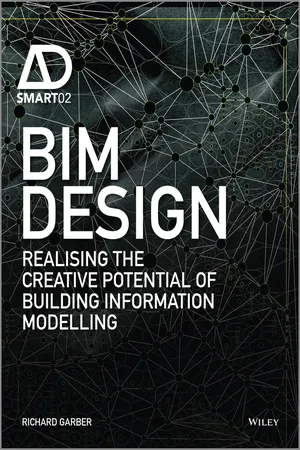
BIM Design
Realising the Creative Potential of Building Information Modelling
- English
- ePUB (mobile friendly)
- Available on iOS & Android
About This Book
Building information modelling (BIM) is revolutionising building design and construction. For architects, BIM has the potential to optimise their creativity while reducing risk in the design and construction process, thus giving them a more significant role in the building process. This book demonstrates how innovative firms are using BIM technologies to move design away from the utilitarian problems of construction, engaging them in a stunning new future in the built environment.
Whereas recent books about BIM have tended to favour case-study analyses or instruction on the use of specific software, BIM Design highlights how day-to-day design operations are shaped by the increasingly generative and collaborative aspects of these new tools. BIM strategies are described as operations that can enhance design rather than simply make it more efficient. Thus this book focuses on the specific creative uses of information modelling at the operational level, including the creative development of parametric geometries and generative design, the evaluation of environmental performance and the simulation and scheduling of construction/fabrication operations.
This book also engages BIM's pragmatic efficiencies such as the conflict checking of building systems and the creation of bills of quantities for costing; and in so doing it demonstrates how BIM can make such activities collaborative.
Throughout, projects are used to illustrate the creative application of BIM at a variety of scales. These buildings showcase work by fi rms executing projects all over the world: SHoP Architects and Construction (New York), Morphosis (Los Angeles), Populous (London), GRO Architects (New York), Reiser + Umemoto (New York), Gensler (Shanghai) and UNStudio (Amsterdam).
Frequently asked questions
Information
CHAPTER 1
INFORMATION MODELLING TODAY
The development of a building information model from design to construction, will be characterised as virtual geometry, the line, which begins to accept additional data, or constraints, as it is refined from sketch form to building proposal. Two-dimensional drawing production can be accommodated, via the profile, or sectioning of virtual geometry, and leads to the generation of the toolpath for computer numerically controlled actualisation or analogue construction.

The shipbuilding and aerospace industries have relied heavily on two aspects of BIM that are only now having an impact on architectural design and the construction industry. First, ship designers have created integrated virtual models that take into account routing of all systems within a boat hull and allow for checks against collisions. Such models allow for the production of shop drawings used by the fabrication team that include individual part information and bills of quantities. Second, these models allow for both automated and manual prefabrication of these ship systems.

WHAT CAN THE DESIGNER EXPECT?
- Construction documentation
- Visualisation (design and construction)
- Material and equipment quantities
- Cost estimates
- 4-D construction sequencing and reporting
- Scheduling
- Fabrication data and toolpaths.
- Visualise multiple design organisations
- Simulate alternatives
- Identify clashes between building equipment
- Communicate design intent three-dimensionally
- Improve productivity.
By understanding the museum as a virtual three-dimensional construction prior to building, Studio Daniel Libeskind was able to translate the sweeping forms of the building’s exterior to interior spaces, such as this contemporary art gallery.

For the construction of the 13,500-square-metre (146,000 ft2) project, the general contractor, Mortenson Construction, adopted BIM technologies and developed the three-dimensional model supplied by Libeskind to support the building’s construction. Mortenson’s team created building information models of the concrete and steel structure for quantification, formwork design, shop drawings and coordination. The building, and ultimately its design and construction process, received recognition from the American Institute of Architects’ fifth annual Technology in Architectural Practice (TAP) Building Information Model (BIM) Awards in 2009.

Increasingly, buildings are being constructed in factories using strict digital controls, much like the shipbuilding and aerospace industries. Future Home Technology, one of several prefabricated building manufacturers that have emerged in the greater New York City metropolitan region, promises customise...
Table of contents
- Cover
- Half Title page
- Title page
- Copyright page
- Acknowledgements
- Dedication
- Foreword Mario Carpo
- Chapter 1: Information Modelling Today
- Chapter 2: The Master Builder and Information Modelling
- SHoP: Architects, Control and Construction: The Barclays Center
- Chapter 3: The C(reative)Onstruction Process, then and now
- Morphosis: Design Intent and Digital Iteration: Perot Museum of Nature and Science
- Chapter 4: New Methods: New Tools
- Populous: Curvilinear Workflows: Aviva Stadium
- Chapter 5: The Digital States and Information Modelling
- Gro Architects: Dense Agendas: Jackson Green Housing
- Chapter 6: Strategies for Component Generation
- Reiser + Umemoto: Architecture by (SEMI) Remote Control: Kaohsiung Port Terminal
- Chapter 7: Assemblies and their Simulation
- Gensler: Simulation Takes Control: Shanghai Tower
- Chapter 8: Conclusions: Authorship and Lines of Development
- UNStudio: Knowledge Architecture for a Life (Cycle): Education Executive Agency and Tax Offices
- Select Bibliography
- Key Search Terms
- End User License Agreement